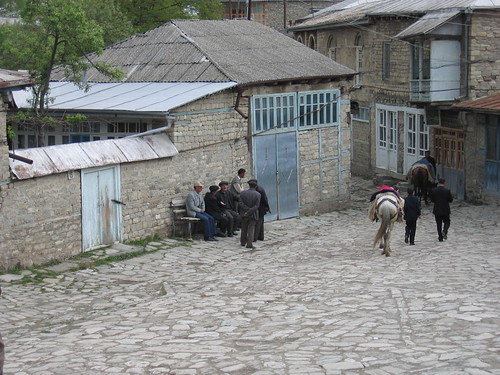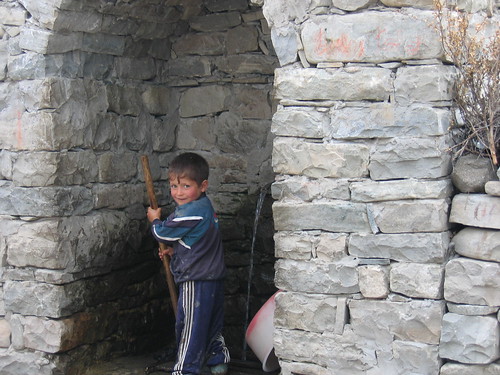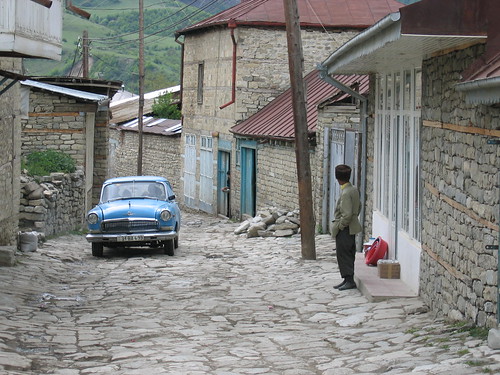Sunday, May 15, 2005
Excursion to Lahic
We made a second trip to Lahic this weekend to see what's going on. Since it's a tiny village of stone houses in the mountains up near the Dagestani border, the answer was, as we expected, "not much." But it's a charming place and it was a beautiful drive (by Azerbaijan standards). The fields are green and wildflowers in bloom.
Lahic is known for its coppermakers, old mosque and unique Caucasian culture. We sat in a tea garden playing the game of "we could live here if...." We also wondered just how much this place had changed in the last decade since the end of the Soviet Union. We decided that the street scenes in front of us probably didn't look that different than scenes from the 70's or 80's. Maybe even farther back than that.

I think these old men were sitting there last time we visited

Residents get their water from spigots like this.

Old Volga
Lahic is known for its coppermakers, old mosque and unique Caucasian culture. We sat in a tea garden playing the game of "we could live here if...." We also wondered just how much this place had changed in the last decade since the end of the Soviet Union. We decided that the street scenes in front of us probably didn't look that different than scenes from the 70's or 80's. Maybe even farther back than that.

I think these old men were sitting there last time we visited

Residents get their water from spigots like this.

Old Volga
Comments:
<< Home
The New York Times
THE NEW YORK TIMES September 16, 1997 Journal: An Isolated Village Whose Treasures Are Global By STEPHEN KINZER LAHIC, Azerbaijan
The first clue to what makes this remote Caucasian village so extraordinary is the gentle tapping sound that spills from workshops along its roughly cobbled streets. Inside, some of the world's most accomplished coppersmiths are using small mallets to decorate plates, trays, jugs, goblets and pitchers just as their ancestors have done for centuries. They are the most visible legacy of an extraordinary artistic tradition that brought Lahic worldwide fame.
The soaring peaks that surround this village make farming impossible, so local people turned very long ago to crafts. Coppersmithing is only the most famous. Almost everyone who lives here can turn shapeless things into objects of quiet and even mystic beauty.
In one small room facing the main square on a recent afternoon, two young men were hunched over a half-finished leather saddle. Nearby, several others were turning lambs' wool into lining for mountain-climbing moccasins. Women were weaving brightly colored leggings thick enough to resist the snowy cold that envelops Lahic for nine months each year.
With a bit of coaxing, a member of the village council, Avos Abbasov, produced a long knife whose exquisitely carved wooden handle bears a sequence of abstract designs culminating in the head of an eagle. He hinted that the art of making handcrafted pistols and hunting rifles, though forbidden by gun-control laws, has not entirely died out here. At a carpet workshop behind the square, women and girls chatted gaily as they sat at hand looms weaving subtle patterns from fresh-spun wool.
The weavers do not converse in Russian or Azeri, this country's two principal languages. Instead, like everyone else who lives here, they use an ancient Persian-based language called Lahic, which is spoken nowhere else. The language suggests that the first settlers on this spectacularly beautiful but forbidding cliff were of Persian descent. Nothing more is known about their background or why they chose to come here, though they evidently placed great value on solitude.
Lahic is connected to the outside world only by a rugged dirt path that winds its way around precipitous gorges and is closed by rain and snow for much of the year. "Long ago it was almost impossible to get here," said Manaf Suleymanov, author of a book on the town's history that was published several years ago in Baku, the Azerbaijani capital. "If you were running away from something or hiding from someone, this would have been the ideal place. Possibly people came here to flee from invaders, or perhaps they were sent by Persian kings to build a stronghold against the Russians. All we know for sure is that it is the hearth of our ancestors, and that Lahic people have done great things in the world."
Crafts from this village have long been treasured by collectors throughout the Middle East and Europe. Traders discovered Lahic crafts many centuries ago, and sold them for high prices at bazaars in Baghdad, Shiraz and other great Middle Eastern cities. A display of copperware made here won a gold medal at the Paris World Exposition in 1878, and today Lahic crafts are on display in museums from London and Paris to Moscow and Istanbul. Inside dozens of workshops and private homes, men and women pull designs from the recesses of their memories and transform them into objects that can be seen and held. Shelves are lined not only with new creations but also with artifacts that carry sparks of this town's unusual history. A shallow brass bowl decorated with a stylized hunting scene was carried in a woolen saddlebag by some solitary traveler who drank from it when he stopped by rivers or streams. A dusty oil lamp made in the 19th century is so evocatively shaped that one is afraid to touch it for fear that a genie might suddenly emerge. No automobile was seen here until the mid-1960s, and although there is now electricity and telephone service, neither functions for more than a few hours a week. Maintaining the utility wires from Baku, 80 miles away, is evidently not a high priority.
It is this splendid isolation that has enabled the 2,000 people who live in Lahic and surrounding hamlets to preserve their melodious language and age-old traditions. "Lahic, a precious living theater for ethnologists, has kept almost perfectly intact a microcosm of cultural features which has preserved its communal harmony and social cohesion across the centuries," according to a recent U.N. report on living conditions in Azerbaijan. "The spirit of the Middle Ages still lingers there." But people in Lahic realize with mixed emotions that the world cannot be held at bay forever.
The population is slowly shrinking as young people seek their fortunes elsewhere, and the supply of copper and other raw materials has dwindled. Few dare to predict how much longer their idyll can last. "Everything that has changed in the world is changing here," said Nagi Aliyev, a retired seventh-generation coppersmith whose six sons have all taken up the trade and whose four daughters are all carpet weavers. "In the time of the czars, people here were millionaires," Aliyev said, recalling the days when Lahic crafts were prized by collectors throughout the known world. "We used to have 700 horses, and even when 40 sheep were slaughtered for a feast, it was not enough to feed us all. What will happen to us now? That is up to future generations." Within his own family, Aliyev may find reason to hope. As he was speaking, one of his dozens of grandchildren emerged from a candy store and stopped to greet him. Asked what he wants to be when he grows up, the boy smiled shyly and replied: "A coppersmith.
Post a Comment
THE NEW YORK TIMES September 16, 1997 Journal: An Isolated Village Whose Treasures Are Global By STEPHEN KINZER LAHIC, Azerbaijan
The first clue to what makes this remote Caucasian village so extraordinary is the gentle tapping sound that spills from workshops along its roughly cobbled streets. Inside, some of the world's most accomplished coppersmiths are using small mallets to decorate plates, trays, jugs, goblets and pitchers just as their ancestors have done for centuries. They are the most visible legacy of an extraordinary artistic tradition that brought Lahic worldwide fame.
The soaring peaks that surround this village make farming impossible, so local people turned very long ago to crafts. Coppersmithing is only the most famous. Almost everyone who lives here can turn shapeless things into objects of quiet and even mystic beauty.
In one small room facing the main square on a recent afternoon, two young men were hunched over a half-finished leather saddle. Nearby, several others were turning lambs' wool into lining for mountain-climbing moccasins. Women were weaving brightly colored leggings thick enough to resist the snowy cold that envelops Lahic for nine months each year.
With a bit of coaxing, a member of the village council, Avos Abbasov, produced a long knife whose exquisitely carved wooden handle bears a sequence of abstract designs culminating in the head of an eagle. He hinted that the art of making handcrafted pistols and hunting rifles, though forbidden by gun-control laws, has not entirely died out here. At a carpet workshop behind the square, women and girls chatted gaily as they sat at hand looms weaving subtle patterns from fresh-spun wool.
The weavers do not converse in Russian or Azeri, this country's two principal languages. Instead, like everyone else who lives here, they use an ancient Persian-based language called Lahic, which is spoken nowhere else. The language suggests that the first settlers on this spectacularly beautiful but forbidding cliff were of Persian descent. Nothing more is known about their background or why they chose to come here, though they evidently placed great value on solitude.
Lahic is connected to the outside world only by a rugged dirt path that winds its way around precipitous gorges and is closed by rain and snow for much of the year. "Long ago it was almost impossible to get here," said Manaf Suleymanov, author of a book on the town's history that was published several years ago in Baku, the Azerbaijani capital. "If you were running away from something or hiding from someone, this would have been the ideal place. Possibly people came here to flee from invaders, or perhaps they were sent by Persian kings to build a stronghold against the Russians. All we know for sure is that it is the hearth of our ancestors, and that Lahic people have done great things in the world."
Crafts from this village have long been treasured by collectors throughout the Middle East and Europe. Traders discovered Lahic crafts many centuries ago, and sold them for high prices at bazaars in Baghdad, Shiraz and other great Middle Eastern cities. A display of copperware made here won a gold medal at the Paris World Exposition in 1878, and today Lahic crafts are on display in museums from London and Paris to Moscow and Istanbul. Inside dozens of workshops and private homes, men and women pull designs from the recesses of their memories and transform them into objects that can be seen and held. Shelves are lined not only with new creations but also with artifacts that carry sparks of this town's unusual history. A shallow brass bowl decorated with a stylized hunting scene was carried in a woolen saddlebag by some solitary traveler who drank from it when he stopped by rivers or streams. A dusty oil lamp made in the 19th century is so evocatively shaped that one is afraid to touch it for fear that a genie might suddenly emerge. No automobile was seen here until the mid-1960s, and although there is now electricity and telephone service, neither functions for more than a few hours a week. Maintaining the utility wires from Baku, 80 miles away, is evidently not a high priority.
It is this splendid isolation that has enabled the 2,000 people who live in Lahic and surrounding hamlets to preserve their melodious language and age-old traditions. "Lahic, a precious living theater for ethnologists, has kept almost perfectly intact a microcosm of cultural features which has preserved its communal harmony and social cohesion across the centuries," according to a recent U.N. report on living conditions in Azerbaijan. "The spirit of the Middle Ages still lingers there." But people in Lahic realize with mixed emotions that the world cannot be held at bay forever.
The population is slowly shrinking as young people seek their fortunes elsewhere, and the supply of copper and other raw materials has dwindled. Few dare to predict how much longer their idyll can last. "Everything that has changed in the world is changing here," said Nagi Aliyev, a retired seventh-generation coppersmith whose six sons have all taken up the trade and whose four daughters are all carpet weavers. "In the time of the czars, people here were millionaires," Aliyev said, recalling the days when Lahic crafts were prized by collectors throughout the known world. "We used to have 700 horses, and even when 40 sheep were slaughtered for a feast, it was not enough to feed us all. What will happen to us now? That is up to future generations." Within his own family, Aliyev may find reason to hope. As he was speaking, one of his dozens of grandchildren emerged from a candy store and stopped to greet him. Asked what he wants to be when he grows up, the boy smiled shyly and replied: "A coppersmith.
<< Home




